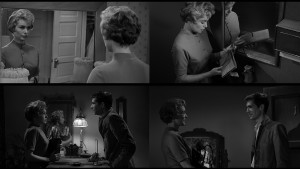What You See in the Dark by Manuel Muñoz is set in Bakersfield, California during the 1950s, which is seen as a Mexican-American neighborhood. The story focuses on the love story between the Dan and Theresa. Dan is a bartender and son of an abandoned wife named Arlene, who owns a local motel and waitresses at a cafe located downtown. Theresa is a shopgirl was also abandoned by her mother, who left to Texas. This sets up the story and with all the conversations we’ve had regarding the Gothic and the uncanny usage of mirrors, I found it interesting how the vocal point of the novel seemed to revolve around reflections, in mirrors, lenses and optical motifs that created a distorted view of how each character views themselves and situations.
The novel takes place in a time of transitional change in society and in the lives of the characters. People are trying to find their identities as well as fulfill their aspiring dreams. One of the most important use of reflections is used as the local cafe’s main glass window. When we first are introduced to the characters of Dan and Theresa, they are being observed through this window as “the two of them sat in full view of everyone passing by, minding their own bushiness” (Muñoz 3). This is important because like all Gothic elements of reflection, the actually scene isn’t always as it seems on the outside. I almost took it as foreshadowing that there is something ominous about this relationship from the beginning that will be played out.
When the main Actress of the movie is being driven to her hotel, she is escorted through “the plain glass doors of the lobby” (Muñoz 87). When she is in her room she looks at “herself one more time in the mirror” thinking “there was no one else like her” which allowed her to get the part in the movie (Muñoz 90). I thought all of the descriptions of her internal experiences in Bakersfield were reflected through the use of mirrors around her. Her appearance makes her question herself and the motives reflected deep in her psyche. Later on in her hotel, she again walked to the mirror and stood in attention in complete self-examination: “She had all afternoon she knew, to stand in front of that mirror in scrutiny, the way empty time manages to hand you nothing but doubt” (Muñoz 104). Mirrors don’t lie and the way these characters look into them, they know they can’t hide their true emotional states and criticisms.
A pivotal scene between Dan and Theresa takes place in Las Cuatro Copas where Theresa sings and plays guitar on stage. The whole scene is played out with her reservations about playing for Dan and a copious amount of mirrors that were far enough so she couldn’t “see herself clearly” but close enough “to see that she would never be a distant figure to anyone in the cantina” (Muñoz 79). She used the mirrors as comfort because “she didn’t want to look in their eyes” (Muñoz 79). The placement of the mirrors in the club gave Theresa a place to look and reflect on her current life and the affinity she has towards music: “She was mesmerized by the sight of her hands caressing the guitar, her fingers moving in time over in that mirror and keeping up” (Muñoz 80). Mirrors offer insight into the inner workings of the mentalities of these characters.
Works Cited:
Muñoz, Manuel. What You See in the Dark. Chapel Hill: Algonquin Books of Chapel Hill, 2012. Print.
Picture:
http://orphanswithguns.files.wordpress.com/2012/06/marian-dopple.jpg


This is a great observation about the use of ones reflection to find some kind of inner truth. I would add that the image that we see in a mirror is aways flipped making it slightly different from reality. This is how we see ourselves, however, and we can never see ourselves through someone else’s eyes. This is a struggle for a lot of the characters in the novel, who see themselves in a certain way but realize that no matter what they do no one will ever see them the way they see themselves. For example, everyone in town gossips about Arlene’s life but the story is different from everyones point of view including her own. As reader’s we have to decide which side of the story we believe since everyones view is somewhat distorted.